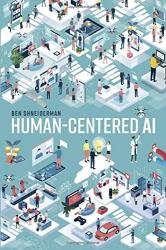Human-Centered AI
- Добавил: literator
- Дата: 14-11-2022, 12:35
- Комментариев: 0
 Название: Human-Centered AI
Название: Human-Centered AIАвтор: Ben Shneiderman
Издательство: Oxford University Press
Год: 2022
Страниц: 401
Язык: английский
Формат: pdf (true), epub
Размер: 121.9 MB
The remarkable progress in algorithms for machine and deep learning have opened the doors to new opportunities, and some dark possibilities. However, a bright future awaits those who build on their working methods by including HCAI strategies of design and testing. As many technology companies and thought leaders have argued, the goal is not to replace people, but to empower them by making design choices that give humans control over technology.
In Human-Centered AI, Professor Ben Shneiderman offers an optimistic realist's guide to how artificial intelligence can be used to augment and enhance humans' lives. This project bridges the gap between ethical considerations and practical realities to offer a road map for successful, reliable systems. Digital cameras, communications services, and navigation apps are just the beginning. Shneiderman shows how future applications will support health and wellness, improve education, accelerate business, and connect people in reliable, safe, and trustworthy ways that respect human values, rights, justice, and dignity.
The first idea is a framework for thinking about technology design, which shows how creative designers can imagine highly automated systems that preserve human control. The examples include familiar devices, such as elevators, self-cleaning ovens, and cellphone cameras, as well as life critical applications, such as highly automated cars, tele-operated surgical robots, and patient-controlled pain relief. The guidelines and examples clarify how designers can support high levels of human control and high levels of automation.
The second idea is to show how the two central goals of AI research—emulating human behavior and developing useful applications—are both valuable.
They generate four pairs of metaphors that could be combined in developing products and services:
1) Intelligent agents and supertools,
2) Teammate and tele-bots,
3) Assured autonomy and control centers, and
4) Social robots and active appliances.
The third idea bridges the gap between widely discussed ethical principles of HCAI and the realistic steps needed to realize them. The book describes how to adapt proven technical practices, management strategies, and independent oversight methods. It guides software team leaders, business managers, and organization leaders in developing:
1) Reliable systems based on sound software engineering practices,
2) Safety culture through business management strategies, and
3) Trustworthy certification by independent oversight.
Technical practices for programmers, designers, software engineers, and team leaders include audit trails to enable analysis of failures, just like the flight data recorders (aviation black boxes, which are really orange boxes) that have made civil aviation such a success story. Then Human-Centered AI explains software engineering workflows, verification and validation testing, bias testing to enhance fairness, and explainable HCAI user interfaces.
"The book is especially relevant to AI researchers and developers... Expanding the variety of inputs into AI design will be essential to achieving Shneiderman's transformative vision of a more human-and humane-future." -- Angelique Taylor, Issues in Science & Technology
About the Author:
Ben Shneiderman is an emeritus distinguished university professor in the Department of Computer Science at the University of Maryland. His widely used contributions include clickable highlighted weblinks, high-precision touchscreen keyboards for mobile devices, and tagging for photos. Shneiderman's information visualization innovations include dynamic query sliders for Spotfire, development of treemaps for viewing hierarchical data, novel network visualizations for NodeXL, and event sequence analysis for electronic health records. Shneiderman is also the Founding Director (1983-2000) of the Human-Computer Interaction Laboratory, and a member of the UM Institute for Advanced Computer Studies (UMIACS) at the University of Maryland. He is a Fellow of the AAAS, ACM, IEEE, NAI, and the Visualization Academy and a Member of the US National Academy of Engineering, in recognition of his pioneering contributions to human-computer interaction and information visualization.
Скачать Human-Centered AI
Внимание
Уважаемый посетитель, Вы зашли на сайт как незарегистрированный пользователь.
Мы рекомендуем Вам зарегистрироваться либо войти на сайт под своим именем.
Уважаемый посетитель, Вы зашли на сайт как незарегистрированный пользователь.
Мы рекомендуем Вам зарегистрироваться либо войти на сайт под своим именем.
Информация
Посетители, находящиеся в группе Гости, не могут оставлять комментарии к данной публикации.
Посетители, находящиеся в группе Гости, не могут оставлять комментарии к данной публикации.
